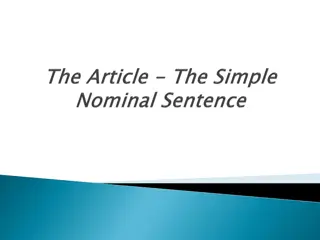Understanding Vowels in English and Arabic
Explore the concept of vowels in English and Arabic languages, including their types, representation, and sounds. Discover the differences between short and long vowels, as well as the unique diphthongs present in Arabic. Learn about nunation and how it is used to indicate indefinite nouns and adjectives. Dive into the fascinating world of vowel sounds with this comprehensive guide.
Download Presentation

Please find below an Image/Link to download the presentation.
The content on the website is provided AS IS for your information and personal use only. It may not be sold, licensed, or shared on other websites without obtaining consent from the author. Download presentation by click this link. If you encounter any issues during the download, it is possible that the publisher has removed the file from their server.
E N D
Presentation Transcript
Vowel: 1. a speech sound made with the vocal tract open 2. A letter, such as a, e, i, o, u, and sometimes y in the English alphabet, that represents a vowel. In linguistics, vowel length is the perceived duration of a vowel sound.
In the English alphabet, there are 5 vowels: A, E, I, O, U. But there are many more vowel sounds in the English language. The number of vowels in English is uncertain, because there are different varieties of English. Examples of vowels: I i / / /a / "twin" / "twine" O o / / /o / "not" / "note" U u / / /ju / "cub" / "cube"
Vowels in Arabic There are 6 vowels - 3 short and 3 long - and 2 diphthongs in Arabic.
Long Vowels The three long vowel sounds in Arabic are represented by the following three letters. 1. 'Alif 2. Waw - 3. Ya' -
Short Vowels The three short vowels sounds in Arabic are represented using the following symbols either above or below the letters. 1. Fatha - indicated by a small diagonal stroke above the consonant. This is the neutral a vowel sound, such as in the words, nun and woman. 2. Kasra - indicated by a small diagonal stroke below the consonant. Similar to the sound in the middle of the word did.
Short Vowels 3. Damma - written like a miniature above the letter. It's pronounced like the u in bull. Sukun - indicated by a small circle above the letter. It is used to signify the absence of a vowel, for example, and .
Diphthongs A diphthong is a combination of two vowel sounds occurring next to each other within the same syllable. The two diphthongs in Arabic are the two sounds: 1. ay as in the word 2. aw as in the word : ": " "
Nunation Nunation is found at the end of nouns and adjectives when they are indefinite. It is indicated using a doubled vowel sign. With the sounds un (double damma), in (double kasra), or an (double fatha). When the fatha is doubled, the letter 'alif is added except when the word end in a ta' marboota.
Stress - The Syllable A syllable is a unit of sound containing either a vowel sound alone e.g. eye, you; or a vowel sound with one or more consonants e.g. not, stop. Examples of two-syllable words: seven, water. Stress: when a word has more than one syllable, one of them is spoken with special force, called stress. A spoken word is recognized not only by its pronunciation but also by its stress pattern. If the pronunciation of a word is correct, but the stress is wrong then the word may not be understood e.g. Record(n): BrE / rek d/ ; NAmE / rek rd/ Record(v): BrE /r k d/ ; NAmE /r k rd/
Stress - The Syllable The Arabic language is a language of syllable length, not stress. While reading Arabic all syllables should be given their full length, but no effort should be made to emphasize any syllable at the expense of the other. The result will sound as if some syllables are stronger than others, but this is because of their length. In Arabic, there are long and short syllables. The long syllable is the one that contains a long vowel preceded by a matching short vowel ( ). The short syllable, on the other hand, contains a short vowel or a diphthong.
Examples: has three short syllables has a long syllable ( ) and a short syllable ( ) has a long syllable ( ) and two short syllables ( ) and ( ) has a short syllable ( ) and a long syllable ( ) has a long syllable ( )and a short syllable ( ) has two short syllables ( ) and ( ) has one short syllable has one short syllable
Abbreviations As in the English language, some abbreviations are used in the Arabic language, such as .
The Alphabet as Numbers The letters of the Arabic alphabet are sometimes used for numbering. The order followed is found in the following line:
Homework Indicate how many long syllables and short syllables are in each of the following words:























